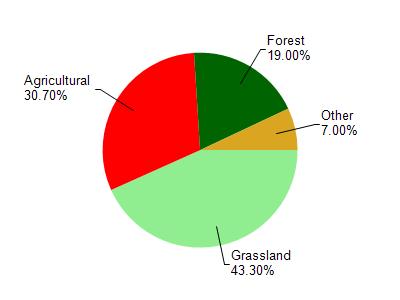Grant
Yes
No
No
Fish and Aquatic Life
Overview
McPherson Branch is a spring-fed cold water tributary to the Platte River near the community of Ellenboro. About 1.5 miles is currently considered a class II trout stream. Recent fish surveys have resulted in the stream being proposed to be upgraded to a class I trout stream (WDNR, 2000). This change, once approved, will make McPherson an Exceptional Resource Water in the State of Wisconsin. Agricultural nonpoint sources of pollution are present in its watershed and McPherson Branch is also listed on the state’s list of impaired streams due to problems resulting from this pollution. Nonpoint source best management practices, particularly stream buffer corridors and managed grazing, would help protect and improve the stream. The Harry and Laura Nohr Chapter of Trout Unlimited is in the process of conducting in-stream habitat work on McPherson Branch during the summer of 2001.
Date 2001
Author Aquatic Biologist
Historical Description
From: Smith, Tom D., and Ball, Joseph R., Lake and Stream Classification Project. Surface Water Resources of Grant County, Department of Natural Resources, 1972. Surface Area = 2.24 acres, Length = 3.7 miles, Gradient = 81 ft./mile Flow = 2.8 c.f.s.
A high-gradient, spring-fed stream beginning four miles southeast of Lancaster and flowing in an easterly direction to empty into the Platte River near Ellenboro. The lower 1.2 miles of stream which is considered to be trout water is fairly deep with a good in-stream vegetation cover. Brown trout are common and a few brook trout can be found. Trout up to 22.2 inches have been taken indicating that they grow well in this stream. Forage species are common and a few smallmouth bass are present in the lower reache8. Caddis fly and fresh- water shrimp are common. Pools are scarce in the upper one-half of the stream and the banks are relatively stable throughout. Muskrats and a few migratory waterfowl inhabit the stream while the upland varieties frequent the surrounding area. Seepage from a garbage dump located on the floodplain in the central portion of the stream is a potential source of pollution. The Platte River and two bridge crossings provide public access. Two dwellings are seen adjoining the stream.
Date 1972
Author Surface Water Inventory Of Wisconsin
General Condition
McPherson Branch (WBIC 951100) from its mouth to its sixth tributary was assessed during the 2018 listing cycle; new biological (fish Index of Biotic Integrity (IBI) scores) sample data were clearly below the 2018 WisCALM listing thresholds for the Fish and Aquatic Life use. This water was meeting this designated use and was not considered impaired.
Date 2017
Author Ashley Beranek
Condition
Wisconsin has over 84,000 miles of streams, 15,000 lakes and milllions of acres of wetlands. Assessing the condition of this vast amount of water is challenging. The state's water monitoring program uses a media-based, cross-program approach to analyze water condition. An updated monitoring strategy (2015-2020) is now available. Compliance with Clean Water Act fishable, swimmable standards are located in the Executive Summary of Water Condition in 2018. See also the 'monitoring and projects' tab.
Reports
Management Goals
Wisconsin's Water Quality Standards provide qualitative and quantitative goals for waters that are protective of Fishable, Swimmable conditions [Learn more]. Waters that do not meet water quality standards are considered impaired and restoration actions are planned and carried out until the water is once again fishable and swimmable
Management goals can include creation or implementation of a Total Maximum Daily Load analysis, a Nine Key Element Plan, or other restoration work, education and outreach and more. If specific recommendations exist for this water, they will be displayed below online.
Monitoring
Monitoring the condition of a river, stream, or lake includes gathering physical, chemical, biological, and habitat data. Comprehensive studies often gather all these parameters in great detail, while lighter assessment events will involve sampling physical, chemical and biological data such as macroinvertebrates. Aquatic macroinvertebrates and fish communities integrate watershed or catchment condition, providing great insight into overall ecosystem health. Chemical and habitat parameters tell researchers more about human induced problems including contaminated runoff, point source dischargers, or habitat issues that foster or limit the potential of aquatic communities to thrive in a given area. Wisconsin's Water Monitoring Strategy was recenty updated.
Grants and Management Projects
Monitoring Projects
| WBIC | Official Waterbody Name | Station ID | Station Name | Earliest Fieldwork Date | Latest Fieldwork Date | View Station | View Data |
|---|
| 951100 | McPherson Branch | 10040965 | McPherson Creek DS 100m from unnamed trib(951300) confluence | 1/1/2015 | 1/1/2015 | Map | Data |
| 951100 | McPherson Branch | 10031761 | McPherson Branch upstream at confluence of unnamed trib | 1/1/2015 | 1/1/2015 | Map | Data |
|

Watershed Characteristics
McPherson Branch is located in the Platte River watershed which is 197.74 mi². Land use in the watershed is primarily grassland (43.30%), agricultural (30.70%) and a mix of forest (19%) and other uses (7.00%). This watershed has 455.07 stream miles, 21.45 lake acres and 1,303.48 wetland acres.
Nonpoint Source Characteristics
This watershed is ranked Medium for runoff impacts on streams, Not Available for runoff impacts on lakes and High for runoff impacts on groundwater and therefore has an overall rank of High. This value can be used in ranking the watershed or individual waterbodies for grant funding under state and county programs.This water is ranked High Stream for individual Rivers based on runoff problems and the likelihood of success from project implementation.